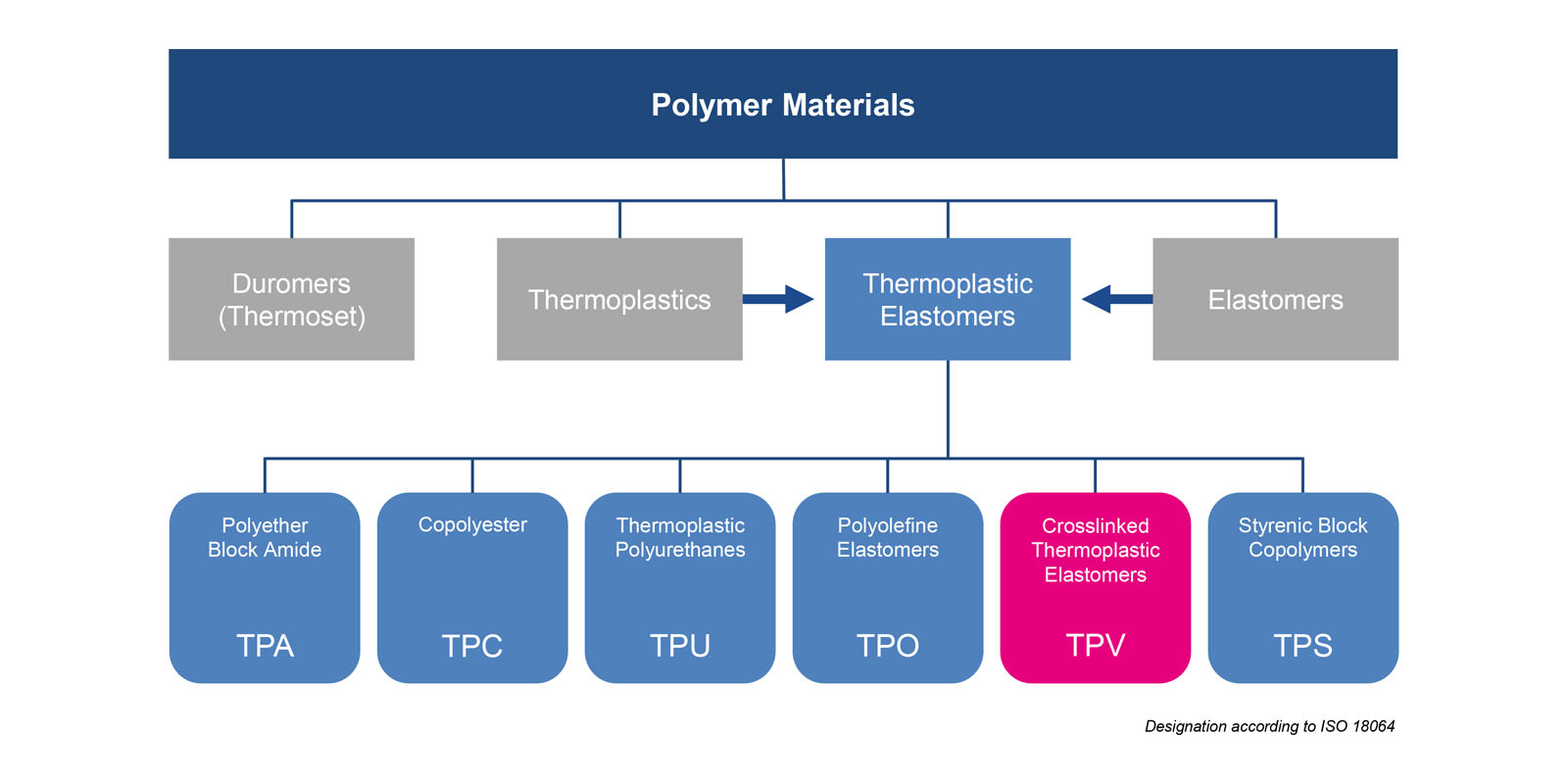What are TPV?
Thermoplastic vulcanizates (TPV)
What are TPV?
TPV is the abbreviation for thermoplastic vulcanizates. TPVs are elastic and thermoplastic processable materials based mostly on polypropylene and EPDM. They form a subcategory within the general group of thermoplastic elastomers (TPE).
How are TPV manufactured?
The various TPV materials are usually manufactured by reactive extrusion. In the classic case, they consist of the two main components polypropylene (PP) and ethylene-propylene-diene rubber, which are mixed together. The EPDM phase is dynamically vulcanized in this blending process. Due to the adapted shear and mixing forces, the resulting rubber phase is very highly dispersed and distributed within the continuous, thermoplastic phase. In addition, further additives such as UV stabilizers, fillers or color pigments can be added to achieve the desired material properties.
In particular, the mechanical properties of TPV compounds are strongly dependent on the degree of distribution and the size of the vulcanized components.
In addition to the classic design of TPV materials as compounds blends of polypropylene and dynamically crosslinked EPDM, which account for the majority of the total quantity of all TPVs, there are a large number of other material combinations. For example, blends of thermoplastic copolyesters and various dynamically crosslinked rubbers including EVM.
How are TPV processed?
TPVs are produced and delivered to the customer in pellet form. The granules from KRAIBURG TPE can be processed without the addition of other substances. There are various ways to process the granules. Among the most commonly used methods are the injection molding and extrusion processes.
Depending on the formulation and properties, it is possible for the materials to form an adhesion to other materials when processed by multi-component injection molding. Existing products from the TPV portfolio allow adhesion with polypropylene (PP), polybutylene terephthalate (PBT) as well as polyamide (PA).
What advantages do TPV offer compared to elastomers?
Unlike elastomers, TPV products no longer need to be vulcanized during processing, which simplifies the downstream processing operation and thus greatly reduces cycle times. Another advantage is the elimination of cost-intensive reworking steps, since the components do not have to be additionally annealed or deburred as is the case with elastomer processing.
If cohesive adhesion is not possible, thermoplastic elastomer hybrids can be mechanically anchored by processing in multi-component injection molding.
Another advantage is the recyclability of TPVcompounds. Sprues and start-up material can be added to the virgin material to a certain percentage.
In addition, KRAIBURG TPE is working intensively on new formulations in which recyclates are already used in the manufacturing process.
Does KRAIBURG TPE produce TPV?
The TEH technology of thermoplastic hybrids (HIPEX®) in the portfolio can be classified in the class of TPV materials almost exclusively.
Classical TPS materials repeatedly reach their limits with regard to their high temperature stability and their behavior towards fuels and lubricants. With the addition of the HIPEX® materials, KRAIBURG TPE offers customers the opportunity to overcome these limitations and expand the range of applications from thermoplastic elastomers to engines, drive or cooling units of all kinds.
The desirable properties of HIPEX® compounds are made possible by their formulation.
Thermoplastic Elastomer (TPE)
Thermoplastic Polyurethane (TPU)
Thermoplastic styrene block copolymers (TPS)
Thermoplastic polyester elastomers (TPC)
Thermoplastic polyamide elastomers (TPA)
Thermoplastic polyolefins (TPO)

